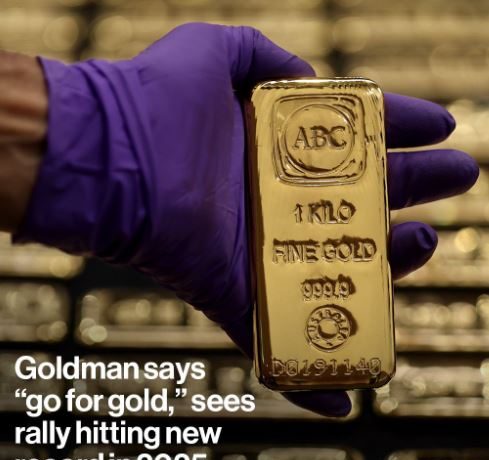Goldman Sachs has placed gold among its top commodity trades for 2025, reaffirming its ambitious target of $3,000 per ounce by December 2025.
The global investment bank’s forecast points to continued upward momentum for the precious metal, driven by a combination of macroeconomic uncertainty, and strong demand.
Gold has been on a remarkable run over the past few years, with its price surpassing key levels, but Goldman Sachs believes this rally is far from over.
According to the bank, gold’s potential for further gains is supported by a confluence of factors that make it one of the most compelling trades in the commodity space for 2024 and beyond.
Why Goldman Sachs Is Bullish on Gold
Goldman Sachs’ updated forecast builds on its previous bullish outlook for the precious metal. Analysts at the bank point to several key reasons why they expect gold prices to continue climbing in the coming years:
With inflation remaining elevated in many parts of the world, particularly in developed economies, central banks may be forced to continue accommodative monetary policies.
These policies, which include low interest rates and continued quantitative easing, are expected to support gold’s appeal as a store of value.
Historically, gold has performed well in inflationary environments, as it is viewed as a hedge against currency devaluation.
Global Economic Uncertainty
Goldman Sachs notes that economic uncertainty—spurred by factors such as geopolitical risks, the ongoing effects of the COVID-19 pandemic, supply chain disruptions, and financial instability—will continue to drive demand for safe-haven assets like gold.
In times of uncertainty, investors typically flock to gold as a reliable store of value and a way to diversify away from more volatile assets like equities.
Shift in Investor Sentiment
The bank also highlights a shift in investor sentiment, with more institutional and retail investors turning to gold as part of their portfolio diversification strategies.
While gold has traditionally been seen as a hedge against inflation, it is also increasingly viewed as an asset that can provide stability during market volatility, particularly in times of political or financial crisis.
Strong Demand from Central Banks
Another key driver for gold’s future price movement is the ongoing purchasing activity from central banks. Many countries, particularly in emerging markets, have been actively increasing their gold reserves.
Central banks have become net buyers of gold in recent years, and this trend is expected to continue as nations look to diversify their foreign exchange reserves away from the U.S. dollar and reduce their exposure to volatile financial markets.
A Strong Year for Gold in 2024?
Goldman Sachs predicts that gold will continue its upward trajectory throughout 2024.
The bank expects economic and geopolitical instability to persist, fueling further demand for gold.
Additionally, the ongoing debate around U.S. monetary policy, inflation, and the strength of the U.S. dollar could create a favorable environment for gold prices to rise.
In the near term, interest rates and the actions of the Federal Reserve will play a significant role in shaping the gold market.
However, Goldman Sachs sees gold maintaining its bullish momentum even if the Fed raises rates moderately in 2024, as inflationary pressures are likely to remain a concern.
Supply Constraints and Other Tailwinds
On the supply side, Goldman Sachs points to potential supply constraints that could further drive gold’s price higher.
Mining output has been stagnating in recent years, and major gold producers are facing increasing costs and geopolitical challenges that could limit new supply in the market.
With demand outpacing supply, these factors could contribute to further upward pressure on prices.
The bank also sees potential upside from the growing use of gold in technology and alternative investments such as gold-backed ETFs (exchange-traded funds).
As investors seek more liquid ways to gain exposure to gold, the popularity of gold-backed ETFs is expected to continue to rise, further supporting the metal’s price.
What Does a $3,000/oz Target Mean?
Goldman Sachs’ $3,000/oz target for gold by December 2025 represents a significant upside from current levels.
As of late 2023, gold is trading around $1,900 to $2,000 per ounce, meaning the bank’s forecast implies a potential gain of nearly 50% over the next two years.
For investors, this presents a compelling opportunity to gain exposure to a commodity that has historically served as a hedge against inflation, currency devaluation, and geopolitical instability.
While there are always risks in commodity markets, Goldman Sachs’ forecast suggests that gold’s fundamentals remain strong in the medium to long term.
A Diversified Portfolio Strategy
Investors looking to add gold to their portfolios in light of Goldman Sachs’ optimistic outlook may consider a diversified approach.
This could include exposure to physical gold (through coins or bars), gold-backed ETFs, and shares in gold mining companies.
Each of these investment vehicles provides different risk/reward profiles, allowing investors to tailor their exposure based on their individual investment goals and risk tolerance.
In addition, investors may look to gold as part of a broader commodity strategy, balancing it with other assets that could benefit from similar macroeconomic trends, such as oil, silver, and precious metals.
Bullish Outlook for Gold in 2025
Goldman Sachs’ reaffirmation of its $3,000/oz gold target by December 2025 underscores the strong fundamentals supporting the precious metal.
With ongoing inflation concerns, economic uncertainty, and a shift in investor sentiment, gold is likely to remain one of the most attractive commodities for investors looking for safe-haven assets.
For those who are looking to position themselves for the long term, Goldman Sachs’ analysis suggests that gold is poised for further gains in the coming years, with the potential to reach new highs as global economic dynamics continue to evolve.






